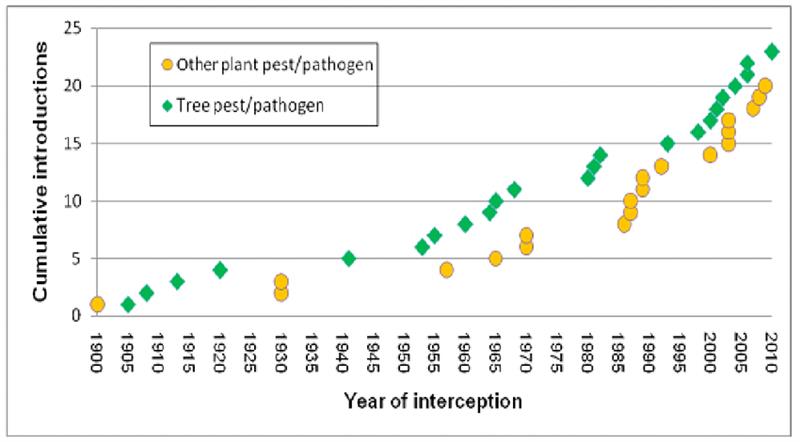
National Plant Health Week 2022
This week is National Plant Health week and Association Technical Officer Owen Baker explores the supply chains associated with plants and plant material, how pests and diseases can be spread and the concept of biosecurity in detail with us below.
The evolution of plants
Plants do not exist in isolation. They evolve over millions of years to adapt to a specific set of environmental conditions, including:
- Rainfall
- Disease
- Predators
- Soil type
- Climate
Native plants that have evolved over a long period of time do not usually cause damage to their environment but are resistant to attacks from native pests and diseases. Similarly, pests and pathogens which have evolved over a long period do not generally cause damage to their native environment.
If a new plant is introduced to an environment (for example, a country), there may be no natural predators or factors to limit its spread. It can therefore breed and spread quickly, and take over an area. Native wildlife may not have developed defences against this new species, resulting in the decline of native species.
Similarly, if a pest or pathogen is introduced to an alien environment, plant species are unlikely to have any resistance. Depending on the ability of the pest or pathogen to spread, this can cause significant losses of native plants.
As recently as the 1950s all plants sold in UK garden centres, wholesalers and plant nurseries were produced (i.e. propagated and grown) in the UK. In most cases, garden centres, nurseries and wholesalers had a propagation and retail area on the same site.
At the time, this method of business was efficient and profitable for nurseries and garden centres, and furnished growers, landscape contractors and gardeners with as many plants as they needed, at the right price.
During this period, rather like historic sale of fruit and vegetables and other perishable goods, plants were considered a seasonal item; just like customers would not expect to purchase summer fruits such as strawberries at Christmas, gardeners respected seasonal variations in availability of plants depending on the time of year. Import of plants was occurring during this period, but only in isolated cases and not on a commercial scale.
In the latter part of the 20th century, globalisation started to have a big impact on trade of fresh produce, which included plant materials. Just as seasonality of fresh fruit and vegetables gradually eroded, so did reliance on plants and plant materials grown or produced in the UK.
The speed of change has been gradual but led to a distinct shift in how plants and plant materials are grown and the availability of plants and plant products in the UK.
There are many reasons for this change, including:
- Affordability of worldwide and European transport solutions
- Access to complex logistical supply chains that allow seeds, transplants, and liners to be moved between growers
- Cheap overseas labour
- Border-free movement of plants and plant material
One of the most significant outcomes from this change was the role of garden centres, wholesalers, and nurseries; most now import their stock rather than growing it themselves on-site. Whilst some UK businesses continue to propagate, many import all stock from Europe or further afield, leaving premises in the UK to perform a retail function only.
As a result of this transition in supply and demand, the UK no longer produces sufficient stock to meet demand from domestic customers, and relies on foreign imports to meet this shortfall.
The result of this change on specifiers, retailers and consumers has been significant and offered many advantages to each group:
Consumers:
- Year-round availability of plants and plant material from local nursery, garden centre or wholesaler
- Limitless supply of plants and plant material
- Consistently high-quality stock
- Stock available at short notice
- Stock of all sizes and levels of maturity available
Retailers:
- No shortage of material to sell
- No risk associated with failed propagation
- Competitive pricing for stock
- Less skilled staff required
- Broader product range available to sell
Whilst the change has brought benefits to many groups of people, it has also introduced challenges. Arguably one of the greatest challenges is how to control pests and diseases brought into the UK accidentally along with plants and planting material.
Pests and diseases have the potential to cause social, environmental, and financial problems not only for retailers and landscape contractors, but stakeholders including the public.

Movement of any commodity from its place of origin via road, air or sea introduces the risk of importing foreign pests, diseases or invasive species. The UK is at risk from invasive plant species, pests and disease when any consignment (not necessarily related to plants or plant products) is imported.
Importing of pests, diseases and invasive species into the UK
Pests, diseases, and invasive species may be imported into the United Kingdom in the following ways:
1. With plants or plant material
- Soil in container
- On living plant material such as leaves, trunk
- On dead plant material
- On packaging e.g. pallets (not necessarily plant related packing)
2. Via natural movement
- Air-borne
- Flight (e.g. Asian hornet)
- Attached to animal fur
- Via water
3. Illegal import of material
Brought back by domestic tourists in luggage for souvenir planting
Dispersal pathway
Local (Several hundred metres from infected plants)
- Rain splashing on infected needles and leaves
- Leaf to leaf contact
- Insect flight
- Wind and gravity
- Tools and equipment
The vast majority of spores from infected trees and plants are usually dispersed within several hundred metres from infected trees or plants.
Mid-range (Hundreds of metres to tens/hundreds of miles)
- Movement of infected plants or plant material (branches, fallen leaves)
- Transport of spores/larvae in soil on vehicles
- Carried on footwear and clothing of people and on birds and animals
- Air currents and mist
- Plant machinery, tools and equipment
Long-range (Tens/hundreds of miles and intercontinental)
- Global trade - Import of live infected plants, contaminated soil or infested timber/packing materials
- Severe weather events and changing climatic patterns
The introduction of pests and diseases has the potential to cause significant loses
Environmental
- Loss of native and naturalised species, habitats and biodiversity
- Loss of rainwater interception and storage capacity leading to increased damage from erosion and flooding
- Loss of carbon storage capacity
- Impact on local climate (loss of cooling, shade, shelter), air quality (more particulate and gaseous pollutants left in the air) and stormwater management
Financial
- Loss and replacement of vegetation (removal, re-planting, timescale to mature)
- Loss and replacement of stock due to infected plants and plant material being unsellable
- Loss and replacement of crops
- Increased cost of processing timber products
- Cost of changes to working practices to include practical biosecurity procedures
- Cost of prevention and control
- Ensuring pest and diseases do not enter the country from overseas with the significant cost of detection, eradication and containment
- Clearance of infected trees and plants costs the Industry and Local Authorities millions of pounds each year
Cultural
- Loss of familiar and iconic landscapes and species – e.g. the impact of Dutch Elm disease in the 1980s
- Loss of amenity – trees and green spaces are vital to making our villages ,towns and cities healthy and attractive places to live
Social
- Public Health risks - the caterpillars of oak processionary moth (OPM) can cause serious skin and respiratory problems
We'll be sharing more useful Plant Health information this #PlantHealthWeek across our channels.

